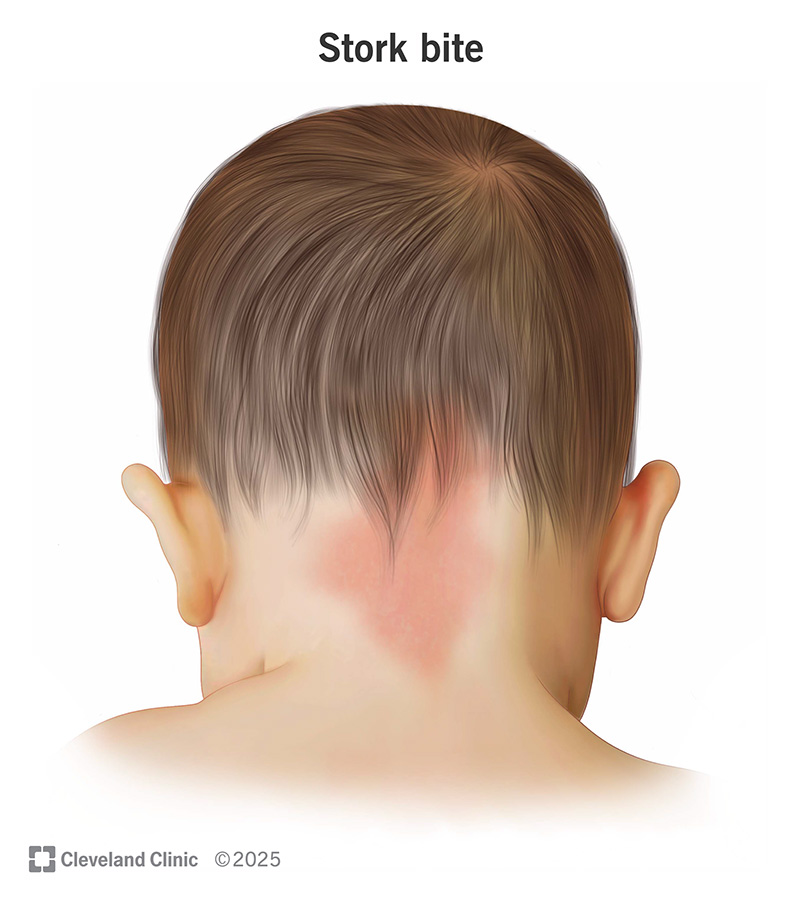Stork bites (nevus simplex) are birthmarks made up of clusters of enlarged blood vessels. They cause areas of pink, red or purplish skin, most commonly on a baby’s forehead, eyelids and the back of their neck and head. They’re very common in newborns. They’re also called salmon patches or angel kisses. Stork bites often fade over time.
Advertisement
Cleveland Clinic is a non-profit academic medical center. Advertising on our site helps support our mission. We do not endorse non-Cleveland Clinic products or services. Policy

A stork bite is an area of pink, red or purplish skin on a newborn’s face, head, neck or back. It’s a type of birthmark caused by enlarged blood vessels just under your skin. They’re most common on your forehead, upper eyelids and the back of your neck.
Advertisement
Cleveland Clinic is a non-profit academic medical center. Advertising on our site helps support our mission. We do not endorse non-Cleveland Clinic products or services. Policy
Babies can be born with many kinds of marks on their skin. But stork bites — also called salmon patches or angel kisses — are often temporary and go away over time. The medical term for a stork bite is nevus simplex.
Stork bites have a unique appearance compared to other birthmarks. They’re:
Stork bites might become more noticeable (turn bright red or purple) when your child cries or gets too warm. They might get lighter temporarily when you put pressure on them, like if you press your finger against one, then let go.
Stork bites most often appear on a baby’s forehead, upper eyelids or back of their neck. Less commonly, they’re found on a baby’s scalp or lower back.
Sometimes, you might hear that a stork bite is a specific type of salmon patch that only appears on the back of your child’s head or neck. But many providers consider “stork bite,” “salmon patch” and “angel kiss” to be terms for a nevus simplex, no matter where they appear on your child’s body.
Stork bites form when blood vessels stretch (dilate) during fetal development. These blood vessels (called capillaries) are close to the surface of your skin. Through babies’ thin, delicate skin, the increased blood flow to the area is visible as a pink, purple or red mark.
Advertisement
No. Stork bites are common and aren’t usually a sign of an underlying medical condition. They’re a type of birthmark that typically only affects your appearance (cosmetic). Very rarely — and only if your child has other physical differences — they’re a sign of Beckwith-Wiedemann syndrome. Your child’s healthcare provider might want to evaluate your child further if they have a stork bite on their lower back and other concerning signs.
There aren’t any special tests that diagnose a stork bite. A healthcare provider (like a pediatrician) will do an exam when your baby is born and in the first few days after birth. They can identify stork bites by looking at them. Sometimes, it can be hard to tell the difference between stork bites and a port wine stain (another type of birthmark).
Since stork bites are harmless and common, they don’t need treatment. If your child’s stork bite doesn’t fade as they grow older, they might want it removed for cosmetic reasons. Laser treatments can lighten or remove a nevus simplex that doesn’t fade.
Contact your child’s healthcare provider if you notice the stork bite:
If your child is born with a stork bite, it might take a year or two to go away. Some last longer, even into adulthood. Stork bites on the back of your child’s head or neck are less likely to completely go away over time.
The myth of stork bites comes from folklore, where storks (large birds) delivered babies. People came up with the term “stork bite” as a cute way of explaining the marks, as if they came from the stork’s beak while carrying the baby by the back of their neck.
Stork bites, angel kisses and salmon patches are all sweet ways to describe clusters of blood vessels you might notice on your baby’s skin. Since you know a large bird didn’t actually bring your bundle of joy to your doorstep, you might be wondering if these marks are harmful. Don’t worry — they don’t hurt your baby and often fade over time. Talk to your child’s provider if you notice any concerning changes or have questions.
Advertisement
As your child grows, you need healthcare providers by your side to guide you through each step. Cleveland Clinic Children’s is there with care you can trust.

Last reviewed on 04/30/2025.
Learn more about the Health Library and our editorial process.